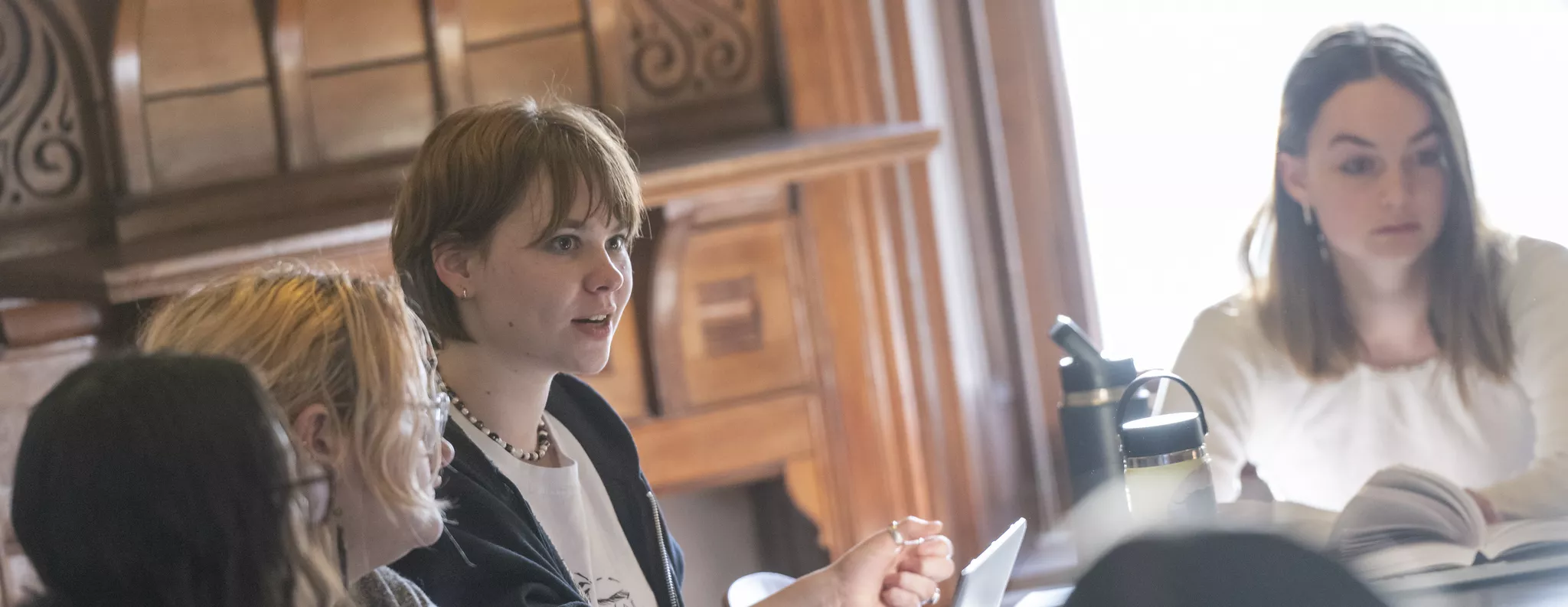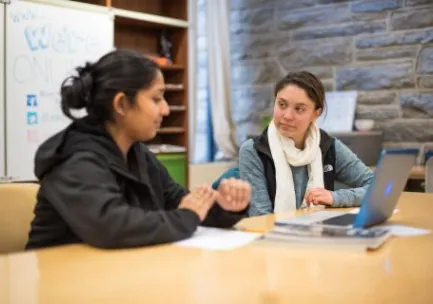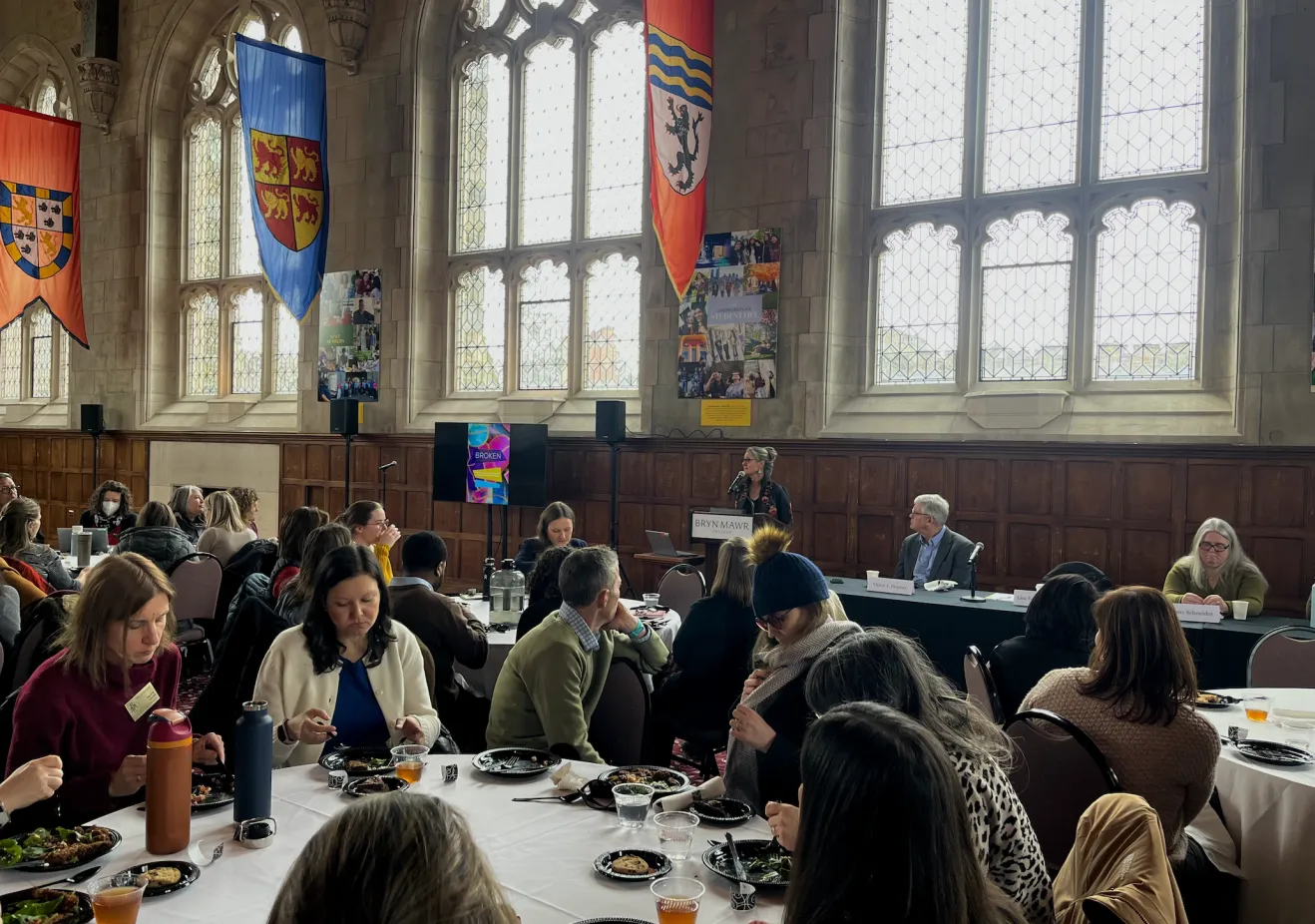
Teaching on Innovation in the Liberal Arts
President Wendy Cadge is funding initiatives to examine how innovation can be taught across the liberal arts.
Projects to Date

AY24-25 Faculty Committee
Committee co-conveners José Vergara and Selby Hearth led faculty and student researchers in examining how innovation can be taught across the liberal arts. Learn more about the AY24-25 Faculty Committee below.

100 Thousand Billion Bryn Mawrs
A Current Topics in Higher Education workshop aimed at answering the question “How can we imagine the range of what’s possible in a Bryn Mawr curriculum?” Learn more about 100 Thousand Billion Bryn Mawrs below.
AY24-25 Faculty Committee
In Fall 2024, Provost Tim Harte and President Wendy Cadge constituted a committee to examine how innovation can be taught across the liberal arts. Faculty were chosen to represent a range of disciplines and roles at the college. The committee visited peer institutions running innovation-related programs, interviewed community members, and surveyed faculty, staff, and students about how Bryn Mawr is currently teaching innovation.
- José Vergara, Associate Professor of Russian
- Selby Hearth, Associate Professor of Geology
- Jamie Taylor, Professor of Literatures in English
- Joel Schlosser, Professor of Political Science
- Monique Scott, Associate Professor of Art History and Africana Studies and Director of Museum Studies Program
- Maurice Rippel, Visiting Instructor of Education and Haverford College alumni
- Sanam Sheriff, Visiting Assistant Professor of Creative Writing and Bryn Mawr College alumni
Student researchers were hired to assemble an annotated bibliography on the research that has been done on teaching innovation:
- Hannah Cosgrove, Class of 2025, Geology major, Spanish minor
- Madeleine Kruckemeyer, Class of 2026, double-major in Physics and Linguistics
- Juliana Vair, Class of 2026, double-major in Mathematics and Comparative Literature (French & German)
- Pearle Bromley, Class of 2028, intended major in Classical and Near Eastern Archeology
100 Thousand Billion Bryn Mawrs
In AY 2024-2025, President Cadge ran a series of workshops called: Current Topics in Higher Education. For the final workshop, President Cadge asked José Vergara (Associate Professor, Russian) and Selby Hearth (Associate Professor, Geology) to run a workshop on the question “How can we imagine the range of what’s possible in a Bryn Mawr curriculum?”
To answer this, on April 4, 2025, we ran an interactive workshop with nearly 100 faculty, staff, undergraduate students, and graduate students. During the workshop, we generated 100 thousand billion (100 trillion) possible Bryn Mawr curricula in about 60 minutes. You can review the workshop process and curricula created below.
The goal of this workshop was not to redesign Bryn Mawr’s curriculum. It was not to identify “the best” Bryn Mawr curriculum — nor even to identify problems in our current curriculum. The goal was to generate novel ideas — to shake up our thinking – through the use of creative constraints.
“Creative constraint” is a method championed by the Ouvroir de Littérature Potentielle (the "workshop of potential literature," stylized Oulipo). This cross-disciplinary collaboration between writers and mathematicians uses constraints to generate new ideas and structures.
Our workshop riffed on a 1961 work by Ouplio co-founder Raymond Queneau: 10 sonnets with each line printed on a strip of paper that can be flipped independently of the rest of the poem. Because each line fits with each poem, the lines can be combined in 1014 different ways, creating 100 thousand billion (100 trillion) different possible poems. It’s called 100 Thousand Billion Poems.
In this workshop, Bryn Mawr faculty, staff, and students assembled a similar project: “100 Thousand Billion Bryn Mawrs.”
There were 14 tables in the Great Hall. Each table had one element of a Bryn Mawr education (e.g., “How could we structure the first-year experience?”). Were these the only elements of a Bryn Mawr education? No, of course not! They were creative constraints.
Each table then brainstormed as many ways as they could imagine that Bryn Mawr could execute that element of its curriculum. From those, each table chose their 10 favorites. They uploaded these to an online form, which fed into an online website.
Each time the web page is refreshed, it selects one random option from each of the 14 categories, generating a new possible Bryn Mawr curriculum. There are 14 categories, with 10 possibilities each, yielding 1014 unique Bryn Mawr educations: 100 thousand billion Bryn Mawrs. Visit the site here. (Please be patient: It can take a few seconds to load the first iteration.)
After the groups submitted their ideas, we had some structured reflections and an informal conversation with Bryn Mawr Artist-in-Residence Ellie Ga, who was there observing and reflecting on our process and products.
We re-ran the workshop on April 5 for the President’s Advisory Council, but with a smaller subset of elements. You can see the curricula they generated here. We ran it again on June 6 with the Bryn Mawr Board of Trustees. You can see the curricula they generated here.
We are working with a book artist to make 100 Thousand Billion Bryn Mawrs into a single book, to live in Special Collections along with Queneau’s work — a snapshot of our collective thinking at this moment.
Mostly, though, this was a communal exercise in intellectual play — a chance for us all to look at the curriculum as if we were (as Queneau put it) “rats who construct the labyrinth from which they plan to escape.”
Acknowledgements
- Hadiyah Al-Gahdari (BMC ‘26) and Shannon Kearns in the President’s Office for coordinating peer institution info for the 100 Thousand Billion Bryn Mawrs workshop.
- Our wonderful LITS team designing the website for 100 Thousand Billion Bryn Mawrs: Emma Dermansky (BMC ‘27 and LITS Digital Scholarship Project Assistant), Alice McGrath (Interim Director of Educational & Scholarly Technology), Cameron Boucher (Educational and Scholarly Technology Assistant), and Alyssa Pivirorotto (Data Science Instructional Support Coordinator and Lecturer).
- Janelle Rebel (Director of Special Collections) for ordering and coordinating copies of Queneau’s book for 100 Thousand Billion Bryn Mawrs.
- Carrie Robbins (Curator of Art & Artifacts) for organizing Ellie Ga’s residency so she could participate in the April 4th Great Hall 100 Thousand Billion Bryn Mawrs workshop.
- Rachel Kunz (President’s Office) for organizing the April 4th Great Hall workshop.
- Tessa Bailey-Findley (Alumnae/i Relations) for organizing the April 5th PAC workshop.
- Amanda Chudnow (Secretary of the College) for organizing the June 6th Board workshop.

